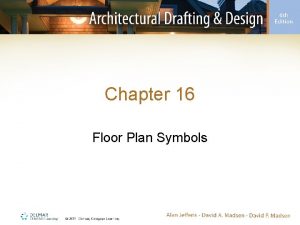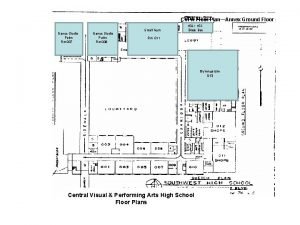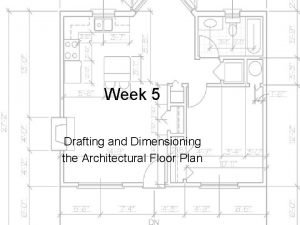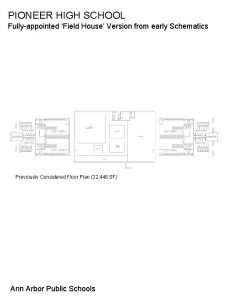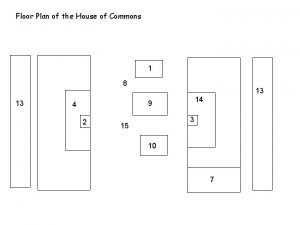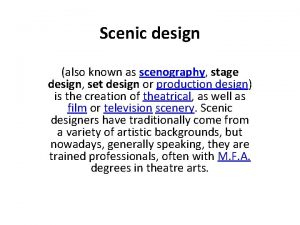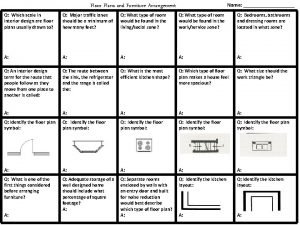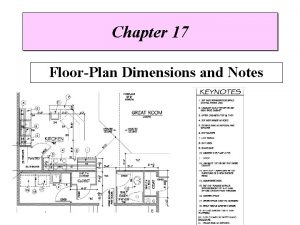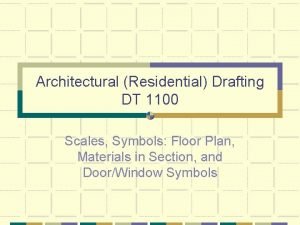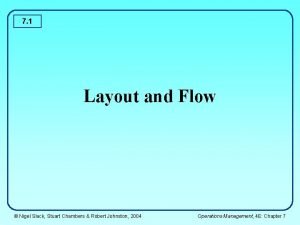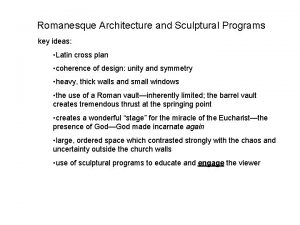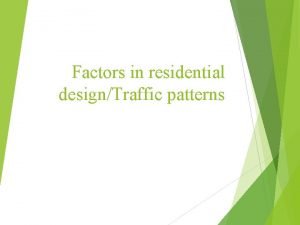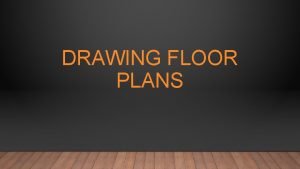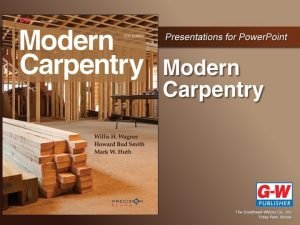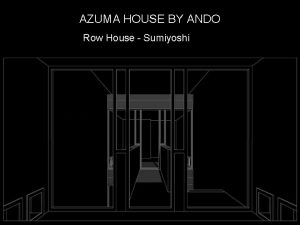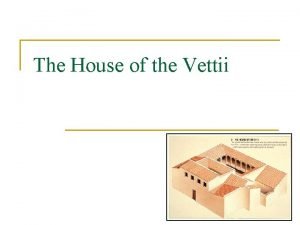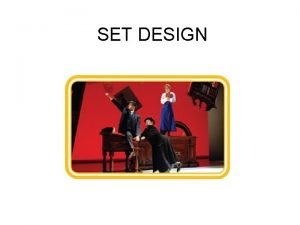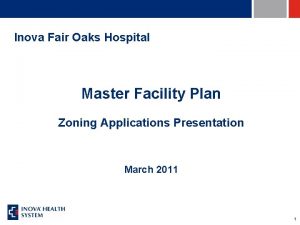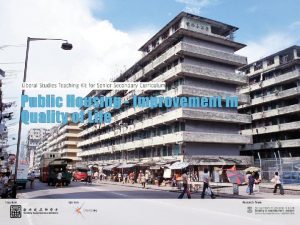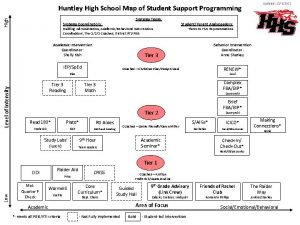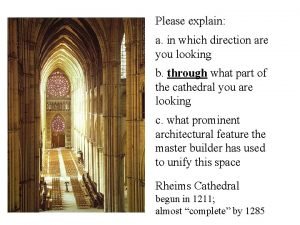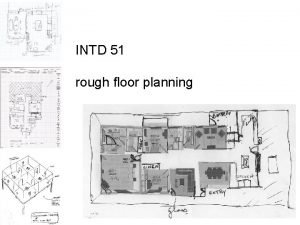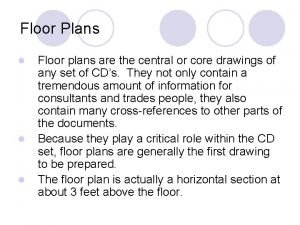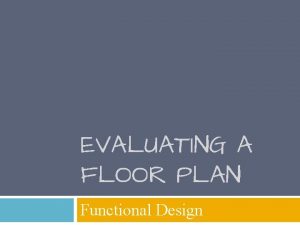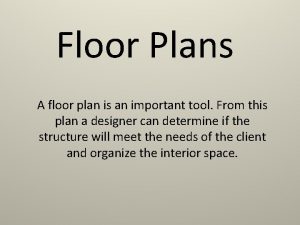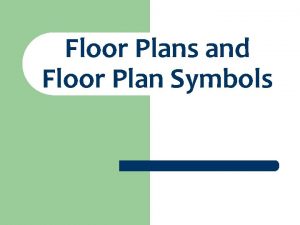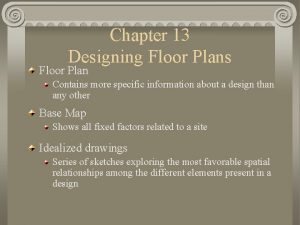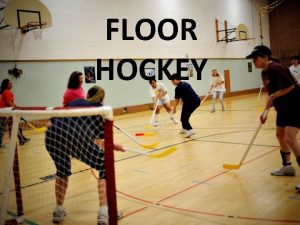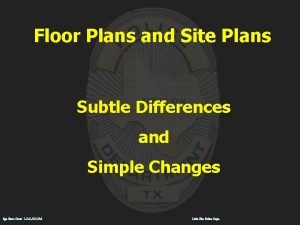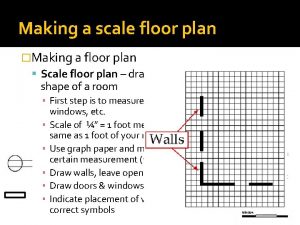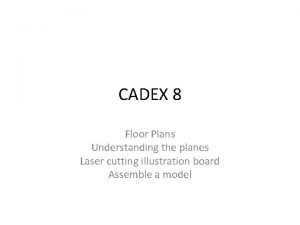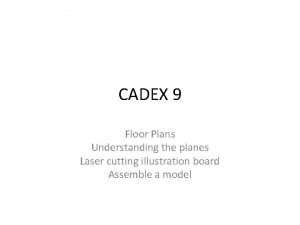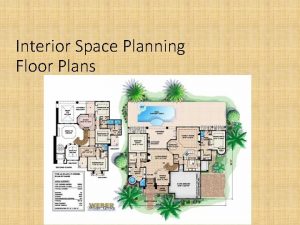Understanding Floor Plans A Floor Plan is n












































- Slides: 44

Understanding Floor Plans

A Floor Plan is― n n n Two-dimensional layout of rooms, walls, and housing features A scaled (2 dimensional ) drawing showing less detail than the blueprints 1 square= ¼ inch= 1 foot Used by all tradespeople Drawn for each floor level of a structure 11’ x 10’

A Floor Plan Shows n n n n Exterior and interior walls Size and location of windows and doors Built-in cabinets and appliances Permanent fixtures Stairs and fireplaces Porches, patios, and decks Room names and approximate sizes

A Floor Plan is Used to: n n Judge space dimensions in a room Determine architectural detail placement in a room Study suitability to lifestyles of the family Putting together a decorating plan for the home

Types of floor plans to consider: n Closed floor plan—separate rooms enclosed by walls with an entry door n n n Benefits: noise reduction, privacy Drawbacks: costly, breaks up space to make it appear smaller Open Floor Plan—few separating walls (bathroom the exception) n n Benefits—saves cost of building material, home tends to appear more spacious Drawbacks—no privacy, noise levels

Three Main Living Areas of the Home n n Living / Social — includes the living room, dining room, family or recreation room, hobby rooms, study, library, etc… Sleeping / Private — includes bedrooms, bathrooms and dressing areas n n Located away from work and social areas Service / Work — includes kitchen, clothes care center, utility room, basement, and garage

Major Areas Broken Down Living Room, Bedrooms, and Kitchen When planning these major areas, consider: n Indoor and outdoor space n Sun exposure n Street noise n Privacy n How rooms relate to one another

What shape of home is least expensive to build? n n A Rectangle Jogs or irregularities in shape increase the cost of the house and should be carefully judged as for convenience and aesthetics.

Housing Orientation n n Placement of the house in respect to: Compass Directions n n n (North, South, East, West) View Sun Wind Other Surroundings

n BLUE PRINT SYMBOLS SHEET n n n Refer to the blue print symbols sheet while the teacher uses the overhead. See if you can figure out which flashcard you have. We will have a quiz on this next time.

Blue Print Symbols Windows= n Doors= n Closets=

Blue Print Symbols Windows= n Doors= n Closets=

Bell Quiz #1 n n n 4. Which statement about floor plans is true? A. The purpose of a floor plan is to show the three-dimensional appearance of rooms, doors, windows, storage areas, and hallways. B. The purpose of a floor plan is to show the two-dimensional appearance of rooms, doors, windows, storage areas, and hallways. * C. It shows the distance between the kitchen wall and base cabinets. D. The work triangle between the refrigerator, the table, and the range is shown. WH

Evaluating Interior Zones Traffic & Circulation Floor Plan Considerations One of the most important tools of the designer is the floor plan. Floor plans can be purchased or custom designed It costs no more to build a house with a good plan, than one with a poor plan……. in fact, it may cost less. The importance of well-arranged floor spaces can not be over-emphasized.

TRENDS IN HOMES (You do not have to take notes on this) n n Homes have gone from an average 1, 695 sq. ft in 1974 to 2, 349 sq. ft. in 2006, even though family size has decreased. Northeasterners had the smallest homes in 1974, they now have the largest. n 19 % said the kitchen was most important n Children’s room mattered least n Walk in closets and plenty of storage is critical

n On the west coast, 1/3 of all garages are 3 car garages. In 1974 only ½ had room for two cars…. 1/2 were 1 car garages. “Flex space” is popular in homes now. Rooms that can do double-duty are important Kitchens occupy about 12% of most homes n Open floor plans are more common now n n

n n 43% of starter homes built this year will contain highspeed wiring. Flat screens are helping to replace the “dedicated media room”. Flat screens are often hidden behind art work, cupboards, etc. In the 1970’s average ceiling height was 7 feet 9 inches. Today the standard is 9 feet on the first floor, 8 feet on the second. Living rooms and dining rooms are less popular today than in 1970

n n Prior to the 1970’s, the average bedroom was 9’x 10’ (about the size of today’s walk-in closets). By the ’ 70’s they were about 11’x 11’. Today it is rare to find bedrooms smaller than 12’x 12. 57% of homes today have 2 and ½ baths. 7 out of 10 homeowners prefer a newly built house to a previously owned one. New buyers consider the living/family rooms as the most important feature

FLOOR PLAN EVALUATION A good floor plan evaluation should include: n An Evaluation of Needs vs. Wants n Well defined 3 basic Areas/zones n Efficient Traffic and circulation patterns n Sizes and shapes of rooms n Use and function of rooms relationships n Useable wall space (not broken up with windows and doors) n Plenty of Storage Space n Lets Break These Down……. And start taking notes

A: Evaluate for Needs vs. Wants n n The first step in evaluating a floor plan is to make a list of your NEEDS and the your WANTS. WHY? n n Needs MUST be filled You may not have enough money to fulfill all your wants.

4 Absolute Housing Needs: n n Enough bedrooms Enough bathrooms Storage and closets Room for furniture and appliances

B: Evaluate the Three Main Living Areas of the Home n n Living / Social—includes the living room, dining room, family or recreation room, hobby rooms, study, library, etc… Sleeping / Private—includes bedrooms, bathrooms and dressing areas n n Located away from work and social areas Service / Work—includes kitchen, clothes care center, utility room, basement, and garage

C: Map Traffic & Circulation Patterns of the Home THINK Frequency of use, Location, and Length n Circulation is the route that people follow as they move from one place to another in the home. Circulation frequency refers to the number of times a route is repeated in any given period of time. n Location and Length of Effective Patterns provides easy access from entry to other parts of home. n

Consider 2 Types of Floor Plans Open vs. closed floor plans Open plans have fewer interior walls n Appear to be more spacious n May be less expensive to build n Less privacy n More noise Closed plans have separate rooms enclosed by walls with an entry door. Noise reduction

4 Basic Types of Circulation n n Family – follows each member of the household throughout the home (hardest to predict, most complex) Service – relates to the movement of people in and out of the home as they make service calls, deliver goods, read meters, take garbage out, … Work – kitchen is generally the hub of the work circulation Guest - involves movement from the entry to the coat closet and to the living room wit access to a powder room. (easiest to predict)

Effective Circulation Guidelines n n n n For efficient circulation patterns, allow for 3 -4 feet of space. Major traffic lanes should be at least 3’ wide. Minor traffic lanes can be 2 -2 ½’ wide. Bathrooms should be located next to bedrooms with easy access. Indoor living areas have easy access to outdoor areas Related rooms are close together. High frequency routes are short, direct, and simple Excessive hall space is avoided. Rooms should not be cut in half by routes Direct access from the main entry of the house to the social / living areas and bathrooms

Other Aspects of Good Circulation n n Easy access to the basement, garage, and storage areas Clothes and care center should be in a convenient location since many trips are made to this work area Service entrance should have easy access near the kitchen and basement stairs Guests should be able to move from the entry to the living area without having to pass through other rooms Guests should have access to a powder room and a coat closet without having to pass through the main portion of the living room.

Work triangle The circulation route between the sink, refrigerator, and range/oven. n n n A clue to the kitchen’s efficiency Should be between 12 - 22 ft in length Small triangles save steps Allows tasks to be done quickly and easily. Too small triangle makes group work difficult Cross traffic causes spills and accidents

6 BASIC KITCHEN LAYOUTS n n n One Wall Corridor L-Shaped U-Shaped Island Peninsula

Draw Your Kitchen n Label the work triangle

D: Sizes and Shapes of Rooms n n Room sizes will be set by the number of rooms needed and the cubic footage possible for a certain amount of money to be spent on that housing type of construction and style. Determine appropriate room size by the necessary amount of furniture and its arrangement, the activities that will go on in the room, and the number of people to use or occupy the room.

E: Room Relationships n Dictate how functional a space will be n Examples n Bathrooms should be located close to bedrooms for convenience and privacy** n Kitchen by garage and the service entrance*** n Kitchen area adjacent to the dining room for ease in serving food. n Plumbing lines located near one another** This will save you money, water, and fuel. n Storage should be incorporated throughout the home**

Room Relationships Cont’d n n n n Related rooms should be close to one another Fireplaces/closets back to back or stacked Easy access from garage to kitchen and storage areas Laundry room close to bedrooms Bathroom near guest area Coat closet by living room Clothes closets between sleeping and activity areas provides a good sound barrier.

Wall Space n n n An effective floor plan consists of useable wall space that is not broken up with windows and doors. Consider location of electrical outlets, television cables, phone plugs, etc… Enough wall space for potential furniture arrangements.

Storage Adequacy and Considerations n n Storage should be incorporated throughout the house – not just in one area. Storage space needs to be adequate— 10 -15% of the home n n Should be convenient and easily accessible n n Food, kitchen utensils, clothes, linen, laundry, misc Easy to clean, to see in to and to reach Storage Types: n Built-in—cannot be moved around the room, an architectural detail of the room n n Cupboards, closets, pantries, etc…. Furniture—can be moved from one room to another n Desks, chests, dressers, trunks, armoires, etc…

Drawing a Floor Plan n Scale: n n 1/4” = 1’ is the most common scale used in architectural and interior design drawings Templates are drawings, symbols, cutouts etc. , used to easily duplicate “too scale” items.

COST OF A HOME n n A conservative estimate for the amount of money to be spent on a home is 3 times the yearly income of the family. Cost of the home is determined by: n n n Cubic foot (size) Location Type of construction Interior finishes and fixtures Lot size, placement, and location n n Main Floor= $100. 00/ sq. foot Second Floor= $75. 00 / sq. foot Basement= $50. 00 / sq. foot Unfinished Basement=$25. 00 / sq. foot

LET’S EVALUATE………

FLOOR PLAN #1

FLOOR PLAN #2

FLOOR PLAN #3

FLOOR PLAN #4

FLOOR PLAN #5

Critique a Floorplan n n Living / Social—includes the living room, dining room, family or recreation room, hobby rooms, study, library, etc… Sleeping / Private—includes bedrooms, bathrooms and dressing areas n n Located away from work and social areas Service / Work—includes kitchen, clothes care center, utility room, basement, and garage
 Body shop floor plans
Body shop floor plans Grade 12 mathematical literacy caps lesson plans
Grade 12 mathematical literacy caps lesson plans Mathematical literacy grade 11 maps and plans
Mathematical literacy grade 11 maps and plans Symbols for floor plans
Symbols for floor plans Dance studio floor plans
Dance studio floor plans Dimensioning floor plans
Dimensioning floor plans Pioneer high school campus map
Pioneer high school campus map The commons floor plans
The commons floor plans Royal paragon hall floor plan
Royal paragon hall floor plan Roman house layout
Roman house layout Scenic designer definition
Scenic designer definition House of menander floor plan
House of menander floor plan Name arrangement
Name arrangement Mosque of selim ii floor plan
Mosque of selim ii floor plan Floor plan studio
Floor plan studio Floor plan notes
Floor plan notes Insulation architectural symbol
Insulation architectural symbol Fixed position layout design
Fixed position layout design Himss 2016 floor plan
Himss 2016 floor plan Technical theatre vocabulary
Technical theatre vocabulary Rit gosnell floor plan
Rit gosnell floor plan Romanesque latin cross plan
Romanesque latin cross plan Romani domus est
Romani domus est Traffic flow floor plan
Traffic flow floor plan Purpose of a floor plan
Purpose of a floor plan Chapter 10 floor framing
Chapter 10 floor framing Questrom tools bu
Questrom tools bu Azuma house ando
Azuma house ando Closet floor plan symbol
Closet floor plan symbol House of the vettii floor plan
House of the vettii floor plan Proscenium stages drawing
Proscenium stages drawing Mattox house floor plan
Mattox house floor plan Inova fairfax hospital floor plan
Inova fairfax hospital floor plan Forensics
Forensics Feng shui floor plan analysis
Feng shui floor plan analysis Gwh floor plan
Gwh floor plan Bahen centre floor plan
Bahen centre floor plan Levittowner floor plan
Levittowner floor plan Hong kong public housing floor plan
Hong kong public housing floor plan Occupational health uhcw
Occupational health uhcw Huntley high school floor plan
Huntley high school floor plan Chip floor plan
Chip floor plan Amiens cathedral floor plan labeled
Amiens cathedral floor plan labeled Rough floor plan
Rough floor plan Cybersquare floor plan
Cybersquare floor plan



